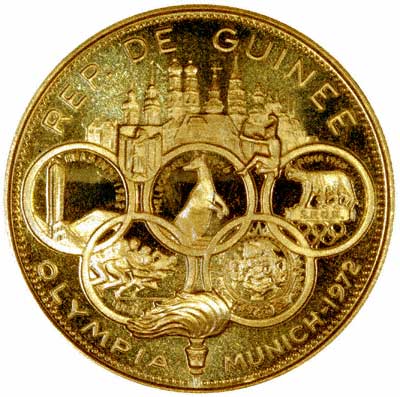| The Very Highest Quality Information... |
| Guinean Coins |
|
| ||||||||||||||||||||||||||||||||||||
 | ||||||||||||||||||||||||||||||||||||
|
| ||||||||||||||||||||||||||||||||||||
Origins
Guinea did not exist as a political entity until after French colonisation, but the land had been inhabited long before that. Prior to European conquest, Ghana, Songhai and Mali Empires, as well as the Sosso and Fouta Djallon kingdoms had all at various points owned territory encompassing modern day Guinea.
Contact with Europeans began in the 16th Century, and Europeans of various stripes had traded with locals for slaves and gold (hence the name of the old British coin, the Guinea).
Formal French occupation and colonisation began in the middle of the 19th Century, but it was not until 1894 that the colony of French Guinea was formally established, lasting until 1958.
Independence
The collapse of the French Fourth Republic in 1958 brought a series of referendums in France's overseas possessions, and Guinea voted overwhelmingly for independence. The new president of Guinea, Ahmed Sekou Toure, rapidly descended into tyranny and oppression. Under Toure, Guinea alternated between allying itself with the USSR and the USA and between socialist and capitalist policies. This unpredictability discouraged foreign investment and the country's wealth declined. Toure died in 1984, and was briefly succeed by his Prime Minister Louis Beavogui, who was overthrown in a coup only a few days later.
Conte
Lansana Conte headed the military Junta that had deposed Beavogui, and he was to govern the country until 2008. Conte attempted to show that under his rule, Guinea was turning away from the bad old days of banana republicanism under his predecessors, releasing many political prisoners and encouraging many exiled Guineans to return. However, poverty and economic decline remained a problem and he eventually repeated the pattern of his predecessors by having dissenters, including the leader of the opposition, arrested and locked up. He died in 2008, leading to a coup by the military. Guinea is currently governed by a military Junta calling itself, without a hint of irony, the 'National Council for Democracy and Development'. It is led by Captain Moussa Dadis Camara.
Coinage of Guinea
Originally, Guinea used coins of the French franc; however, this was replaced in the late 1940s by the western CFA franc, which is still used by many former French colonies. However, as one of the first African French colonies to win independence, Guinea detached itself from what was then still a French-controlled currency and issued its own Guinean franc in 1959.
Aluminium bronze 1, 5, 10 and 25 franc coins were issued upon its introduction, but these were soon replaced in 1962 by a new issue made of cupronickel. The franc was replaced by a new currency called the syli in 1971 at the rate of 10 francs to 1 syli and was subdivided into 100 cauri (a reference to cowri shells which once circulated as currency in the region. Coins of 1, 2, 5 and 50 sylis were also issued, all struck in aluminium.
A new Guinean franc was introduced at par in 1985, and today, coins of 1, 5, 10, 25 and 50 francs are issued for use in circulation.
For Sale and Wanted
If you are interested in coins from Guinea please see our product index:-
Guinean Coins
| ...at the Lowest Possible Price |
|
32 - 36 Harrowside, Blackpool, Lancashire, FY4 1RJ, England.
Telephone (44) - (0) 1253 - 343081 ; Fax 408058; E-mail: info@chards.co.uk The URL for our main page is: https://24carat.co.uk |
Web Design by Snoop |